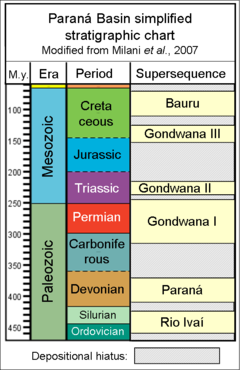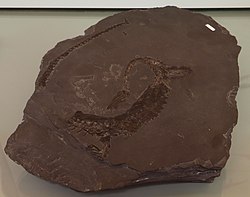Irati Formation
 From Wikipedia the free encyclopedia
From Wikipedia the free encyclopedia
| Irati Formation | |
|---|---|
| Stratigraphic range: Early Permian ~ | |
 The Irati Formation belongs to the Gondwana I megasequence | |
| Type | Geological formation |
| Unit of | Passa Dois Group |
| Underlies | Serra Alta Formation (Paraná Basin) Teresina Formation (Pelotas Basin) |
| Overlies | Palermo Formation |
| Area | 1,000,000 km2 (390,000 sq mi) |
| Thickness | up to 80 m (260 ft) |
| Lithology | |
| Primary | Black shale |
| Other | Sandstone |
| Location | |
| Coordinates | 25°30′S 50°42′W / 25.5°S 50.7°W |
| Region | Paraná & Pelotas Basins Goiás, Mato Grosso do Sul, Mato Grosso, São Paulo, Paraná, Santa Catarina, Rio Grande do Sul |
| Country | |
| Type section | |
| Named by | White |
| Year defined | 1908 |
| Approximate paleocoordinates | 45°48′S 29°42′W / 45.8°S 29.7°W |
 The Paraná Basin in South America | |
Irati Formation is the name of a geological formation of the Paraná Basin in Brazil. It has previously been dated as Late Permian using palynomorphs, but is now dated as Early Permian using zircon ages obtained from bentonite layers. The base of the formation has been dated at 278.4 ± 2.2 Ma.[1][2] Exposures of the Irati Formation are to be found in the South (Geopark of Paleorrota), southeastern Brazil and in the states of Goiás, Mato Grosso, São Paulo, Paraná, Santa Catarina, Rio Grande do Sul and Mato Grosso do Sul.[1] The formation is part of the Passa Dios Group, underlying the Serra Alta Formation and overlying the Palermo Formation. The formation has been deposited in a restricted marine environment.[3] The Irati Formation, with a maximum thickness of 80 metres (260 ft), was defined and named by White in 1908.[4]
Fossil content
[edit]Color key
| Notes Uncertain or tentative taxa are in small text; |
Reptiles
[edit]| Reptiles of the Irati Formation | ||||||
|---|---|---|---|---|---|---|
| Genus | Species | Location | Stratigraphic position | Material | Notes | Image |
| Brazilosaurus | B. sanpauloensis | A mesosaurid mesosaur |  | |||
| Mesosaurus | M. tenuidiens | A mesosaurid mesosaur |  | |||
| Stereosternum | S. tumidum | A mesosaurid mesosaur |  | |||
Fish
[edit]| Fish of the Irati Formation | ||||||
|---|---|---|---|---|---|---|
| Genus | Species | Location | Stratigraphic position | Material | Notes | Images |
| Amelacanthus | A. sp. | A ctenacanthid shark | ||||
| Fairchildodus[5] | F. rioclarensis | A petalodont | ||||
| Iratiacanthus | I. santamariaensis | A sphenacanthid shark | ||||
| Itapyrodus | I. punctatus | A petalodont | ||||
| Orodus | O. ipeunaensis | A orodontid shark | ||||
| Sphenacanthus | S. sanpauloensis | A sphenacanthid shark | ||||
| Taquaralodus | T. albuquequei | A diplodoselachid shark | ||||
| Xenacanthus | X. pricei | A Xenacanthid shark | ||||
Crustaceans
[edit]| Crustaceans of the Irati Formation | ||||||
|---|---|---|---|---|---|---|
| Genus | Species | Location | Stratigraphic position | Material | Notes | Images |
| Iraticaris | I. damiani | |||||
| Myelontordoxylon | M. camposii | |||||
| Permocaris | P. purperae | |||||
| Pittinucaris | P. wuerdigae | |||||
See also
[edit]References
[edit]- ^ a b Da Costa, 2015, p.28
- ^ Ventura Santos et al., 2006
- ^ Diduch, 2011, p.21
- ^ Da Costa, 2015, p.12
- ^ Chahud, A. (2023). "Holocephali from the Irati Formation (Paraná Basin), Brazil: Origin, paleogeographical and paleoenvironmental considerations". Estudios Geológicos. 79 (2). e155. doi:10.3989/egeol.44987.632. S2CID 261376731.
Bibliography
[edit]- Da Costa, Guilherme Estevam (2015), Fácies sedimentares e composição de folhelhos da Formação Irati (Eopermiano) da Bacia do Paraná na região de Bom Retiro, Leste de Santa Catarina (PDF), Universidade Federal de Santa Catarina, UFSC, pp. 1–67, retrieved 2017-08-03
- Diduch, Ana Paula (2011), Descrição de Crustacea Malacostraca da Formação Irati, Permiano Superior, Bacia do Paraná, Brasil (PDF), Universidade Federal do Paraná, UFPR, pp. 1–52, retrieved 2017-08-03
- Piñeiro, G.; Ramos, A.; Goso, C.S.; Scarabino, F.; Laurin, M. (2012), "Unusual Environmental Conditions Preserve a Permian Mesosaur-Bearing Konservat-Lagerstätte from Uruguay", Acta Palaeontologica Polonica, 57 (2): 1–299, doi:10.4202/app.2010.0113
- Ventura Santos, Roberto; Souza, Paulo A.; Souza de Alvarenga, Carlos José; Luiz Dantas, Elton; Martins Pimentel, Marcio; Gouveia de Oliveira, Claudinei; Medeiros de Araújo, Laury (2006), "Shrimp U–Pb zircon dating and palynology of bentonitic layers from the Permian Irati Formation, Paraná Basin, Brazil", Gondwana Research, 9 (4): 456–463, Bibcode:2006GondR...9..456S, doi:10.1016/j.gr.2005.12.001